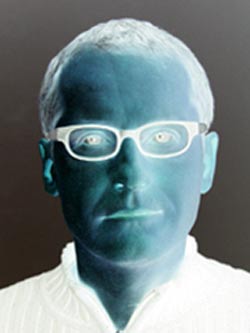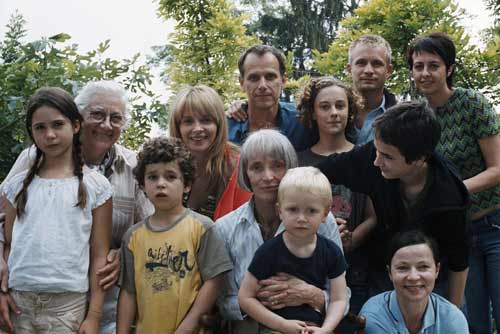
At the opposite end of some sort of rainbow from Roger Ebert is James Quandt, senior programmer of the Cinematheque Ontario and tireless scourer of the globe for lost prints of important films. His work often results in retrospectives that redefine a filmmaker's career or revive interest in forgotten masters. The prints he assembles, if we're lucky, work their way through the world's (too few) cinematheques, and if we're luckier still they end up on DVD, so I've been the indirect beneficiary of his efforts through many darkened screenings at the Pacific Film Archive in Berkeley and now a few at the Gene Siskel Film Center in Chicago.
Plus, I've only seen three of the ten films on his list (or four of the eleven, depending on how you manage the tally), which is perfect. His list appears in Artforum and comes to us online via my friend Girish Shambu. Please click through to see Quandt's top ten films of 2008.
Unlike Ebert's list, which for this active moviegoer elicits a string of yays and nays but very little action, Quandt's list has a different impact: it goes, almost in its entirety, onto my "films to see" list.
His rules are clearly different. Where Ebert limited himself to films released in the US this year, Quandt seems to have drawn from whatever he saw this year, which I'm betting was a fair bit. And I know from his previous lists, essays, and the aforementioned retrospectives that he appreciates formal, distinctive films and seems to hold little interest in a particular actor's career, a film's
In short, his list -- whether he intends it to or not -- fights the year-end canon, the list of films anointed by an amalgam of year-end lists to achieve a brief and (we often discover later) unwarranted degree of attention.
But he fights the canon in another way that strikes at the heart of film festival mavens. I enter each film festival with a list of films I want to see and leave with a list of films I regret missing. Someone who goes to a festival and sees a bewildering number of movies and then returns to the web or the pub to chat about them with others who are doing the same, may sometimes convince herself that she's seen everything worth seeing. She may even scramble in those final days to catch a few more talked-about films and seal up the event with a little Tupperware burp.
But the illusion of exhaustiveness is a dangerous trap.
Examples: I had the opportunity to see 24 City, Tony Manero, and Wonderful Town, but I passed them up after getting the sense that they weren't very good or that they were less important than other movies.
Choices must be made, of course -- you can't see everything, and word of mouth is as good a predictor as anything -- but Quandt reminds me that this goose step is not cinema, it's sampling. The films I wrote off sight unseen are someone else's favorites of the year. And not just someone but James Freaking Quandt, a cinephile so hardcore he can "extrude marrow from hummingbird bones" with a stare through his rectangular glasses. Don't point those peepers at me, man.
I even walked out of the also-ran that he mentions in #9, Nuit de Chien, knowing that I didn't have a handle on it or the filmmaker, Werner Schroeter, with whom I remain unfamiliar. That wasn't necessarily the wrong choice for me -- I'll get a little context and try again one day -- but once again I must remember that my own ignorance is not the same as a viewing, an opinion, a reading, a response, a thought, or anything but perhaps a belch.
- Number of films on Quandt's list that have US distribution: one
- Number with primarily English dialogue: zero
- Number that appear on both Ebert's and Quandt's lists: zero
- Why this means one of them is right and the other is wrong: it doesn't
Sorry to go all subjective and relative and it's-all-good on you in the middle of a numerical tally, but that's the world, man, that's the world.

Of the films in Quandt's list, here's what I've seen:
Le Genou d'Artémide by Jean-Marie Straub, his first film since the death of his collaborator and spouse Danièle Huillet, is an experimental short that seems to sing in multiple registers, some of which may be outside of what humans can hear without training. In Toronto where I saw the film, whenever I would encounter someone who liked it, I'd always ask why. Not rhetorically, but inquisitively. I find Straub and Huillet's films -- which I've very lightly sampled -- to be utter mysteries, so foreign in design that I have trouble even talking about them. And I honestly love to hear people try. Earlier this year I saw Pedro Costa's loving documentary about the pair, and I'd like to see it again one day after I've watched more of their films.
Of the three films that Quandt presents without comment, two are Straub or Straub-Huillet films. That seems fitting, but I'd love to read his comments.
Another is Summer Hours by Olivier Assayas, a film that I included near the top of my Toronto recap and one that fit nicely into an entire slate of family-based films that arrived -- from around the world -- at this year's fest, this one focusing on the objects (furniture, paintings, mementos) owned by a deceased woman. They're the tokens of her life and her family, objects she loved but objects about which her family feels differently. It's a film that feels conventional until it drifts through a museum where some of the woman's belongings wind up and then drifts through her house where a teenage granddaughter is having a sprawling party, each sequence such a contrast from the other, and from the woman's own warm home of old desks and paintings, that a meditation on lasting legacy carries the film into the closing credits. Summer Hours stars an ensemble cast that includes Juliette Binoche, and it's been picked up for US distribution by IFC.
Finally, Liverpool. It, too, screened in Toronto, and were you to stop the film half way through -- or two-thirds of the way, or nine-tenths -- and ask me to put it into a category, I'd have lined it up with the Straub, probably. It's a feature-length fiction film, but given the long, dialogue-free, action-free stretches of a man traveling to see his family, and given that it screened in the same small theater where the Straub and other avant-garde films were shown -- the home of the Cinematheque Ontario -- it seems to belong to a world of abstraction. This won't come as a surprise to people who've seen Alonso Lisandro's previous film, Los Muertos; they're of a piece. But would it be possible for the last minute of such a film to knock it slightly into a different key, to line it up comfortably alongside Summer Hours and the other family films where keepsakes hold meaning that can't be expressed with words, even by blood relatives?
The film from Quandt's list that I'm most eager to see is The Headless Woman by Lucretia Martel. But why? Well, in part because I do know and like this filmmaker's previous movies, especially The Holy Girl, and since she's only made a couple of features so far, I'm eager to see how the trajectory continues. However, I also want to see it because the film was much talked about and debated at Cannes and was noticeably absent from the Toronto lineup. But I wonder how many of the people who complained about its omission had seen the other films on Quandt's list? Beware the one true canon, even from well-meaning cinephiles.
For our next list, we'll shift gears yet again. Check back.




In the January 2009 issue of Sight & Sound, Quandt includes these comments about the Straub-Huillet films: "The high point of Cannes and of the year, Jean-Marie Straub’s twin farewells to a past in which political resistance was a matter of life and death, and to his beloved partner and co-director Danièle Huillet, achieve rending nobility."